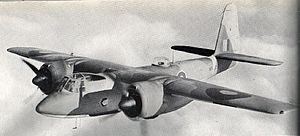Miles M.33 Monitor
| M.33 Monitor | |
|---|---|
 |
|
| Role | Target tug |
| Manufacturer | Miles Aircraft |
| First flight | 5 April 1944 |
| Primary user | None |
| Number built | 22 |
The Miles M.33 Monitor was a twin-engined British target tug aircraft designed and built by Miles Aircraft towards the end of the Second World War. Intended for use by the Royal Air Force and the Fleet Air Arm, the aircraft did not enter service with either.
The Monitor came about as a response to Specification Q9/42 for a twin-engined high-speed target tug for the Royal Air Force. The specification called for a towing speed of not less than 300 mph (480 km/h), be capable of 90 mph while streaming targets, an endurance of 3–4 hours and - most unusually - be capable of being dismantled and fitted into standard packing crates. Two prototypes were ordered; the first prototype (Serial Number NF900) first flew on 5 April 1944, and was capable of reaching 360 mph (580 km/h).
The Monitor was a high-winged aircraft with an all-metal fuselage and wooden wings. It was originally stipulated that the aircraft would incorporate the Bristol Beaufighter wing and landing gear to speed up design and production, but owing to increased demand for the Beaufighter only the landing gear was used, and a new all-wood one-piece wing was designed. The aircraft was powered by two Wright Cyclone R-2600-31 radial engines driving Hamilton Standard Hydromatic propellers. It was fitted with a novel hydraulic winch as the normal windlasses could not be used at speeds of much more than 150 mph (240 km/h), while the Monitor was required to tow targets at double this speed.
The original requirement for a target towing aircraft for the RAF was abandoned, and the orders for Monitors was taken over by the Fleet Air Arm, who required an aircraft capable of simulating dive-bombing attacks on warships. To meet this requirement the aircraft, fitted with hydraulically actuated dive brakes, nose cameras for marking Fleet gunnery, a dorsal midship cupola and radar equipment was used to accurately determine height was known as the Monitor TT Mk II.
...
Wikipedia
